เทคนิคการขยายแบนด์วิดท์ของสายอากาศช่องเปิดที่ป้อนด้วยท่อนำคลื่นระนาบร่วม สำหรับระบบการสื่อสารไร้สาย
##plugins.themes.bootstrap3.article.main##
摘要
บทความนี้นำเสนอเทคนิคการขยายแบนด์วิดท์ของสายอากาศช่องเปิดที่ป้อนด้วยท่อนำคลื่นระนาบร่วม
สำหรับระบบการสื่อสารไร้สาย โดยใช้เทคนิคการตัดช่องเปิดของสายอากาศให้เป็นขั้นบันได และการแทรกแผ่นสตริปลงในช่องเปิดของสายอากาศเพื่อขยายแบนด์วิดท์ให้มากขึ้น และทำการจำลองโครงสร้างของสายอากาศ โดยนำเอาระเบียบวิธีเชิงตัวเลขมาใช้ในการวิเคราะห์ด้วยวิธีระเบียบวิธีผลต่างสืบเนื่องจำกัดในโดเมนเวลา (FDTD) และนำมาเปรียบเทียบวิธี MoM ด้วยโปรแกรม IE3D ซึ่งเป็นโปรแกรมที่ใช้ในการวิเคราะห์โครงสร้างของสายอากาศได้หลากหลายรูปแบบและเป็นที่ยอมรับโดยทั่วไป ในการออกแบบสายอากาศนี้จะทำการวิเคราะห์พารามิเตอร์ของสายอากาศบางตัว เพื่อดูคุณสมบัติของสายอากาศ ประกอบด้วย การสูญเสียเนื่องจากการสะท้อนกลับ (S11) แบนด์วิดท์ อินพุตอิมพีแดนซ์ (Zin) อัตราส่วนแรงดันคลื่นนิ่ง (VSWR) ความหนาแน่นกระแสไฟฟ้า สนามแม่เหล็ก สนามไฟฟ้า การแพร่กระจายคลื่นสนามระยะไกล และ อัตราขยาย ตามลำดับ ผลที่ได้จากการจำลองจะได้ความถี่ และแบนด์วิดท์ครอบคลุมมาตรฐานของโครงข่ายท้องถิ่นไร้สายคือ IEEE 802.11 b/g (2.4-2.4835 GHz) IEEE 802.11j (4.9-5.0 GHz) IEEE802.11 a (5.150-5.350GHz) และโครงข่าย WiMAX (2-6 GHz) นอกจากนี้ยังสามารถพัฒนาสายอากาศเพื่อนำไปใช้งานกับย่านความถี่แบบแถบกว้างยิ่ง (UWB) โดยมีแบบรูปการแผ่พลังงานสนามระยะไกลเป็นแบบสองทิศทาง
##plugins.themes.bootstrap3.article.details##
The manuscript, information, content, picture and so forth which were published on Frontiers in engineering innovation research has been a copyright of this journal only. There is not allow anyone or any organize to duplicate all content or some document for unethical publication.
参考
Federal Communications Commission, 2002. “First Report and Order, Revision of Part 15 of the Commission’s Rules Regarding Ultra-Wideband Transmission Systems,” FCC.
C. A. Balanis, 2005. Antenna theory analysis and design, third editions, John Wiley & Son, Inc.
R. Garg, P. Bhartia, I. Bahl and A. Ittipiboon, 2001. Microstrip Antenna Handbook, Boston: Artech House.
I. J. Bahl, and P. Bharita, 1980. Microstrip Antenna, Dedham: Arthech House.
K. F. Lee and W. Chen, 1997. Advances in Microstrip and Printed Antennas, New York John Wiley & Sons, Inc.
W. Kueathaweekun, N. Anantrasirichai, J. Nakasuwan, and T. Wakabayashi, 2007. “Broadband Slot Antenna Fed by Microstrip Line”, ICEAST , 21-23 November, Thailand.
Y. Shih-Huang and W. Kin-Lu, 2002. “Dual-band F-Shaped Monopole Antenna for 2.4/5.2 GHz WLAN Application”, IEEE Antennas and Propagation Society International Symposium, vol. 4, Jun.
H. D. Chen, J. S. Chen, and Y. T. Cheng, 2007. “Modified Inverted-L Monopole Antenna for 2.4/5.2 GHz Dual-Band Operations,” Electron. Letter, Vol.39:1567-1568.
C. Horng-Dean, 2003. “Slot Antenna Coupled by Microstrip Line for Dual Frequency,” IEEE Trans. on Antennas and Propagation, Vol. 51, No. 8:1982-1986.
P. Jearapraditkul, W. Kueathaweekun, N. Anantrasirichai, O. Sangaroon and T.
Wakabayashi, “Bandwidth Enhancement of CPW–Fed Slot Antenna with Inset Tuning Stub”, ISCIT, 21-23 October, Vientiane, Lao.
W. Kueathaweekun, P. Jearapraditkul, N. Anantrasirichai, O. Sangaroon, and T.
Wakabayashi, 2008. “Wide-band CPW-fed Slot Antenna with Tuning Stub and π-Strip for WLAN/WiMAX Application”, ISPACS, 8-11 December, Bangkok, Thailand.
Zeland Software, Inc., IE3D, New York.
Yongxi Qian, Tatsuo Itoh, 1999. “FDTD Analysis and Design of Microwave Circuits and antennas Software and Applications”, Tokyo: Realize Inc.

